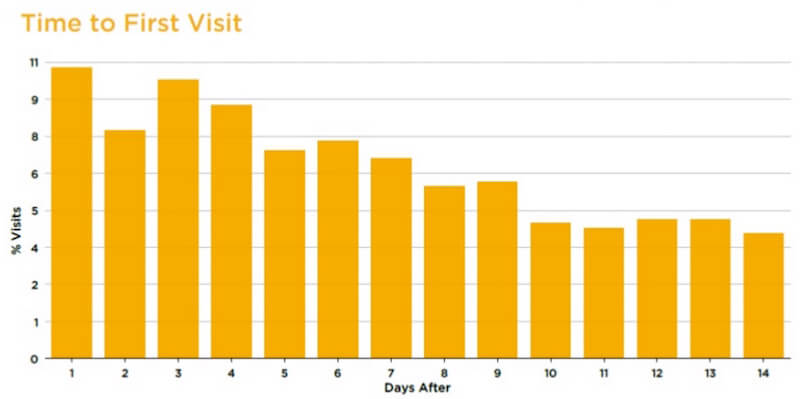The way that customers interact with brands has changed a lot over the last decade, particularly when it comes to high-dollar purchases. Customers use more channels to engage with brands while having detailed product research just a Google search away. This can present some interesting challenges for automotive attribution, jewelry stores, and even online universities.
Many customers are channel-neutral. They’ll seek every avenue to learn more about your business and product before making their final buying decision. Whether that means engaging with you on social media, seeking out reviews from third-party websites reading through the content on your website, or coming into your physical location and speaking with a sales rep — understanding where these engagements take place, what happened during the engagement, and how they all tie together to create a cohesive customer experience is essential. It’s essential both for improving and optimizing the customer’s journey.
Let’s say you owned an auto dealership. A customer learns about your business through an ad that they hear on the radio. Initially, they aren’t fully committed to buying a vehicle. Maybe they’ve been considering it but haven’t done enough research to pull the trigger at this time.
Over the next few weeks, they’ll continue to hear your radio ads occasionally and build awareness of your brand. Eventually, they decide to go to your website. They’ll browse through the different vehicle pages, read articles you’ve published, and check out your social media pages. They’ll start researching vehicles that they are interested in on third-party websites, and looking up customer reviews for your business. They might see an ad on TV, or run into ads that you’ve placed on Google or Facebook. One day, they come into your shop and buy the car.
How do you make sense of it all? How do you know what touchpoints had an impact on their ultimate decision to buy from you? The LeadsRx’s multi-channel attribution tool bridges this gap. By monitoring touchpoints both online and offline and using our advanced attribution systems to assign worth to each engagement that you have with a customer, you’ll be able to see the complete customer journey… from online activity to offline, all within a single unified view.
Improving Customer Experience Requires a Multi-Channel Approach
For retailers, understanding the impact of your online and offline marketing can be a difficult task. Most have no idea when a customer first started engaging with their brand, and they certainly have no idea how each individual touchpoint affected the consumer’s decision to purchase along the way.
The truth is that customers are constantly evaluating your company and products through both online and offline channels. Even while they are in your store, they are looking up reviews about your products and services. Today 80% of Americans are online shoppers, compared to just 22% in 2000. Of those, four out of five will use digital channels to compare prices when shopping before purchasing. Still, only 9% of all purchases are actually made online.
Brands that focus on a single channel, or online and offline experiences of customers are missing the big picture. It’s extremely rare that a company buys a high-dollar item without first interacting with your brand on multiple different channels.
In fact, a 2017 study by Harvard Business Review found that 73% of shoppers used multiple channels during the buyer’s journey. To optimize the customer’s experience on a single channel might be useful when they do use that channel, but you won’t be doing much for their experience as a whole. Companies that sell through multiple channels generate 190% more revenue than merchants that only sell through a single channel.
While in the past it would have been impossible to reliably track customers through both online and offline channels, technology has created an opportunity to track and leverage data to help your company better understand your customers and make data-driven decisions. LeadsRx allows you to integrate marketing touchpoints and conversion events at the user-level regardless of where they take place — online or offline.
Taking a look at the auto dealership example again — a dealership that only tracked digital touchpoints without looking at how they interconnect with non-digital touchpoints would have a hard time understanding how critical channels like radio and television ads actually are in the car buying decision-making process. And, without the ability to incorporate an offline conversion, like the sale of a vehicle, auto dealers would have no insight into what’s driving their most imporant business outcome. Continued interaction with your brand helps to keep your brand top-of-mind, which is so critical for decisions as big as buying a new car, which will affect them for years to come.
Digital Natives vs. Digital Immigrants
Despite the fact that digital channels play a role in most purchasing decisions, it is also important to understand that sometimes buying decisions (especially in B2B sales where millennials are less likely to be in positions to make the final buying decision, although that is becoming more commonplace), the final part of the buying decision may lie with someone that has not fully embraced digital.
These are what is often referred to as digital immigrants — those that came of age before digital channels were a thing or before they were so pervasive in everyday life. Millennials that are digital-savvy increasingly have a say in influencing buying decisions. However, baby boomers and Generation Xers still make most of the final calls in B2B enterprise settings. In fact, in 64% of all B2B deals that involve big ticket items, a C-suite executive makes the final call.
Knowing how to find the balance when buying teams feature individuals of different ages with different backgrounds can be difficult. They may interact with your company through different channels, require different reassurances throughout the process, and have different concerns.
The average number of people involved in B2B purchases has grown from 5.4 to 6.8 in recent years. It’s not just that the number of people involved in these transactions that has grown, either. The people involved in the decision-making process come from a wider range of roles and locations. Because each stakeholder will have their own needs and concerns regarding your product, this can make it difficult for the team to operate in a way that is anything other than cautious. This leads to longer buying cycles. While the average B2B buying cycle ranges depending on your product and industry, many deals can take 3 months or more to complete.
The differences between digital natives and digital immigrants don’t just affect B2B deals, either. They play a role in B2C transactions as well. Consider the concept within the context of the auto dealership we have discussed throughout the article. You would probably like to tailor all touchpoints to your specific customers. Digital immigrants are less likely to put a lot of stock in digital touchpoints and will rely more heavily on offline interactions and sales conversations in their decision-making process.
If you wanted to optimize a campaign that was targeting an older demographic, the campaign should probably lean more heavily on offline channels. That isn’t to say that you should completely neglect digital channels — digital immigrants still use the internet to perform research and learn about your company. But, having an understanding of the digital usage habits of your demographic should play a key role in any campaign. Using a solution like multi-channel attribution from LeadsRx, you can better understand how to optimize your campaigns and touchpoints for the experience your customers want to have.
Offline Touchpoints Create a Digital Response
One important thing to consider is how offline touchpoints throughout the customer journey affect customer actions. Often, offline touchpoints may be the first interaction that a customer has with your business. That initial interaction can spawn additional touches through both offline and digital channels.
In the context of the auto dealership — a customer may hear a radio ad for the company or a specific car that they sell, which leads them to checking out your website. In the auto industry, it is extremely rare for a sale to happen through digital channels alone. Almost all sales include some sort of face-to-face sales process. That doesn’t make this digital response any more impactful on their ultimate decision to buy as this research phase allows them to gain an understanding of whether the specific car they are considering (and your company) are the right fit for them. Without the digital response, the customer would never be truly interested in buying the car.
Ultimately, consumers purchase cars at the dealership and not online. Still, to gain an understanding of the experience the customer had and the journey that they went through, you have to connect all of the touchpoints together. It is essential for understanding the true value of all of your marketing efforts.
With attribution, you can optimize your processes to facilitate a digital response. By measuring how long it typically takes a customer to seek you out through digital channels after engaging with an offline touchpoint, you can follow up with them digitally to help push their awareness and level of engagement forward.
Without proper online and offline attribution, you’d never be able to identify opportunities for improvement like this. Attribution helps you to better understand the actions that customers typically take as they go through the buyer’s journey, and create touches that help to facilitate their movement through the funnel. Without it, you lack the required understanding to make the right optimizations.
LeadsRx registers the exact time that a radio or TV spot is aired. Then, we measure the lift in online traffic and revenue for the time period after the advertisements air. Even if the offline advertisement doesn’t lead to purchases right away, you can still track the effectiveness of the ad by inferring which customers took digital actions based on having viewed the ad. Even if they had previously interacted with your company, our system can determine when a customer likely took action based on their engagement with offline advertisements and other touchpoints.
A Two-Way Street
Online and offline attribution doesn’t just help customers understand how customers who first engage with offline touchpoints are brought into the fold. Our system also helps our customers to measure and understand the effect that their online ads had on offline sales.
LeadsRx uses location tracking to determine when online ads have created a non-digital response as well. For instance — if a customer saw an online ad for the car dealership, then two days later their GPS tracker states that they visited the dealership for an hour, we can infer that the ad led them to take offline action.
The main point that we want to drive home here is that automotive attribution for both offline and online channels complement each other, giving companies deep insights into the actions of different customer personas. With this information, you can more accurately gauge how effective specific advertisements are for your business.
The Missing Link
Most of our customers come to us completely in the dark regarding how their online and offline channels work together to facilitate a positive customer experience. They know that there are interactions taking place there. They know that customers that see offline advertisements might take online actions to learn more and vice versa. But — they have no idea how to quantify how often that is happening or how substantially it affects their ultimate ability to create sales.
LeadsRx helps companies to bridge this gap. Our advanced system helps companies to quantify how often customers engage with their advertisements and touchpoints (both online and offline) and infer when they take actions based on those engagements.


